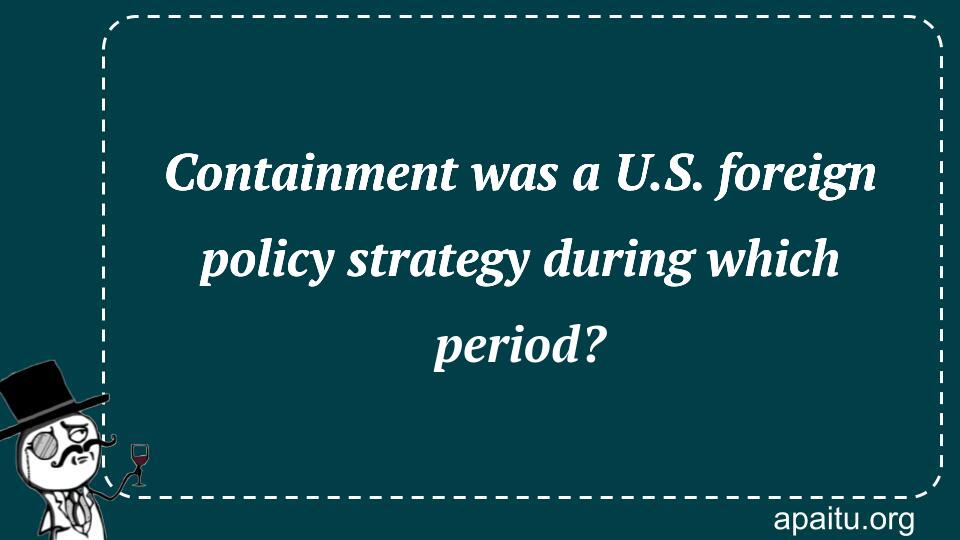Question
Here is the question : CONTAINMENT WAS A U.S. FOREIGN POLICY STRATEGY DURING WHICH PERIOD?
Option
Here is the option for the question :
- Cold War
- Roaring ’20s
- Iraq War
- Bronze Age
The Answer:
And, the answer for the the question is :
Explanation:
The United States embraced containment as a foreign policy tactic in 1947, at the beginning of the Cold War, to stop the spread of communism. Throughout the Cold War, containment took many different forms, including military action and the provision of economic help to nations that were fighting Soviet hegemony.

The period of the Cold War, spanning roughly from the end of World War II to the early 1990s, was characterized by a significant foreign policy strategy known as containment. This strategy, adopted by the United States, aimed to curb the spread of communism and limit the influence of the Soviet Union and its allies. The concept of containment shaped the geopolitical landscape of the time and had far-reaching implications for international relations, diplomacy, and military engagements.
After World War II, the United States and the Soviet Union emerged as the two superpowers, each with starkly contrasting ideologies and aspirations. The Soviet Union, under the leadership of Joseph Stalin, sought to expand its influence and promote the spread of communism worldwide. In response, the United States, led by President Harry S. Truman, devised the strategy of containment as a means to counter Soviet expansionism and protect its interests and those of its allies.
The core principle of containment was to prevent the further spread of communism by containing its influence within existing communist states and preventing its expansion into non-communist territories. This approach was based on the belief that if the Soviet Union and its allies were not allowed to gain additional territory or control, the inherent weaknesses of communism would eventually lead to its downfall.
To implement containment, the United States employed a combination of political, economic, and military means. Diplomatic efforts were made to form alliances and strengthen ties with non-communist nations, providing them with economic aid, military support, and security guarantees. The North Atlantic Treaty Organization (NATO), established in 1949, became a cornerstone of the containment strategy, forming a collective defense against Soviet aggression.
Economically, the United States implemented policies such as the Marshall Plan, which aimed to rebuild war-torn Europe and promote economic stability. By offering financial assistance to European countries, the United States sought to strengthen their economies and prevent the appeal of communism as an alternative to poverty and instability.
Militarily, the containment strategy led to the involvement of the United States in several conflicts during the Cold War. The Korean War (1950-1953) and the Vietnam War (1955-1975) were fought as part of the broader effort to contain communism and prevent its spread in Asia. These conflicts highlighted the tensions and proxy battles that characterized the Cold War era.
The containment strategy also had significant implications for the development of nuclear weapons and the arms race between the United States and the Soviet Union. Both superpowers engaged in a race to build larger and more powerful nuclear arsenals, creating a state of mutually assured destruction. The fear of a global nuclear conflict loomed large during the Cold War, further intensifying the need for containment and deterrence.
The effectiveness of the containment strategy can be debated, as it had mixed results in different regions of the world. While communism was successfully contained in Western Europe and other parts of the world, it gained significant influence in countries such as China, Cuba, and Vietnam. Nonetheless, the containment policy shaped the foreign policy decisions of the United States for several decades and had a profound impact on the global balance of power.
The end of the Cold War in the early 1990s marked a significant shift in international relations, as the Soviet Union dissolved and the ideological struggle between communism and capitalism lost its intensity. The strategy of containment had served its purpose, and the world entered a new era of geopolitical dynamics.
the period of the Cold War was defined by the foreign policy strategy of containment. This approach, adopted by the United States, aimed to limit the spread of communism and counter the influence of the Soviet Union and its allies. Through diplomatic alliances, economic aid, and military engagements, the United States sought to prevent the expansion of communism into non-communist territories. While the effectiveness of containment can be debated, its impact on international relations during the Cold War era was significant and far-reaching. The containment strategy shaped the geopolitical landscape and influenced the course of history for several decades.